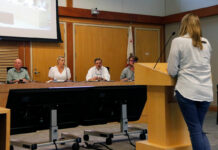“How will we feed ourselves?” asked Joseph McIntyre last month to a packed house at Santa Rosa’s Luther Burbank Center for the Arts.
The question seemed naïve, he admitted, especially to a room full of food system leaders, from the Ag Commissioner to county supervisors, school food service directors to countless organizations serving the hungry, young farmers, entrepreneurial innovators and more. “But that question,” suggested McIntyre, President of Ag Innovations and host of the day’s gathering, “defines all civilizations.”
And while there was plenty to discuss at this year’s Food Forum since the first was held four years ago — shifting markets, new technologies, a proposed ban on locally-grown GMOs — the hottest topic at this year’s follow-up was made clear early on: “The greatest threat to a good food system,” McIntyre concluded, “is poverty and declining incomes. Any self-proclaimed Food Movement that doesn’t take that to heart is bound for failure.”
The day’s goal was to reexamine the landmark Healthy & Sustainable Food Action Plan created by the Sonoma County Food System Alliance, a “shared vision for a healthy, sustainable, and just food system” that emerged out of the initial Food Forum. Last month, its sequel reconvened that same community to evaluate the Action Plan, a barometer for the health of our food system.
So, how are we doing? A mixed bag, it seems.
Take healthy eating: while the percentage of Sonoma County children who eat at least five servings of fruits and vegetables per day rose from 58 percent to 70 percent, we learned that obesity and diabetes are still on the rise.
While the number of certified organic farms and food producers grew from 199 to 290, stories of food-producing farmers going out of business were in no short supply, as so many struggle to find affordable land and provide livelihoods for their workers, let alone for themselves.
And as Suzy Grady of Petaluma Bounty pointed out, households in Sonoma County deemed “economically self-sufficient” (i.e. making three times the poverty level) actually dipped despite our recovery from the Great Recession. In the past four years, wages for food system workers rose only 7.7 percent, while rental costs countywide have exploded 40 percent.
One step forward, another step back.
Food systems aren’t really about food; they’re about people. The challenges we face are therefore people challenges. And so during his presentation on what the future of that system holds for us, David McCuan, Ph.D., professor of Political Science at Sonoma State University, asked us “Who are the people behind our food system and who, in the coming decades, will comprise its voters, consumers, policymakers and entrepreneurs?” Our three fastest-growing constituent groups, says McCuan, are unmarried women, people of color, and Millennials.
As elsewhere in the nation, those three demographics together were responsible for 80 percent of population growth in the past decade and this year may, for the first time in American history, comprise half the electorate. The decisions that will shape our food system will be made largely by this new, ever-changing majority.
Might single women enter the food industry profession in ways distinct from men or married women? How will a Latino electorate influence policies related to food system workers? And what will result from an influx of Millennials — the biggest surge of consumers since the Baby Boom — who’ve grown up with mainstreamed organics, artisanal products and the omnipresent smartphone?
No one knows for sure. But while last month’s Food Forum began a conversation so central to the health of our community, it’s time now to make room at the table for those emerging voices, the new faces of Sonoma County. And time for the rest of us to listen closely.
— Evan Wiig is the executive director of the Farmers Guild








